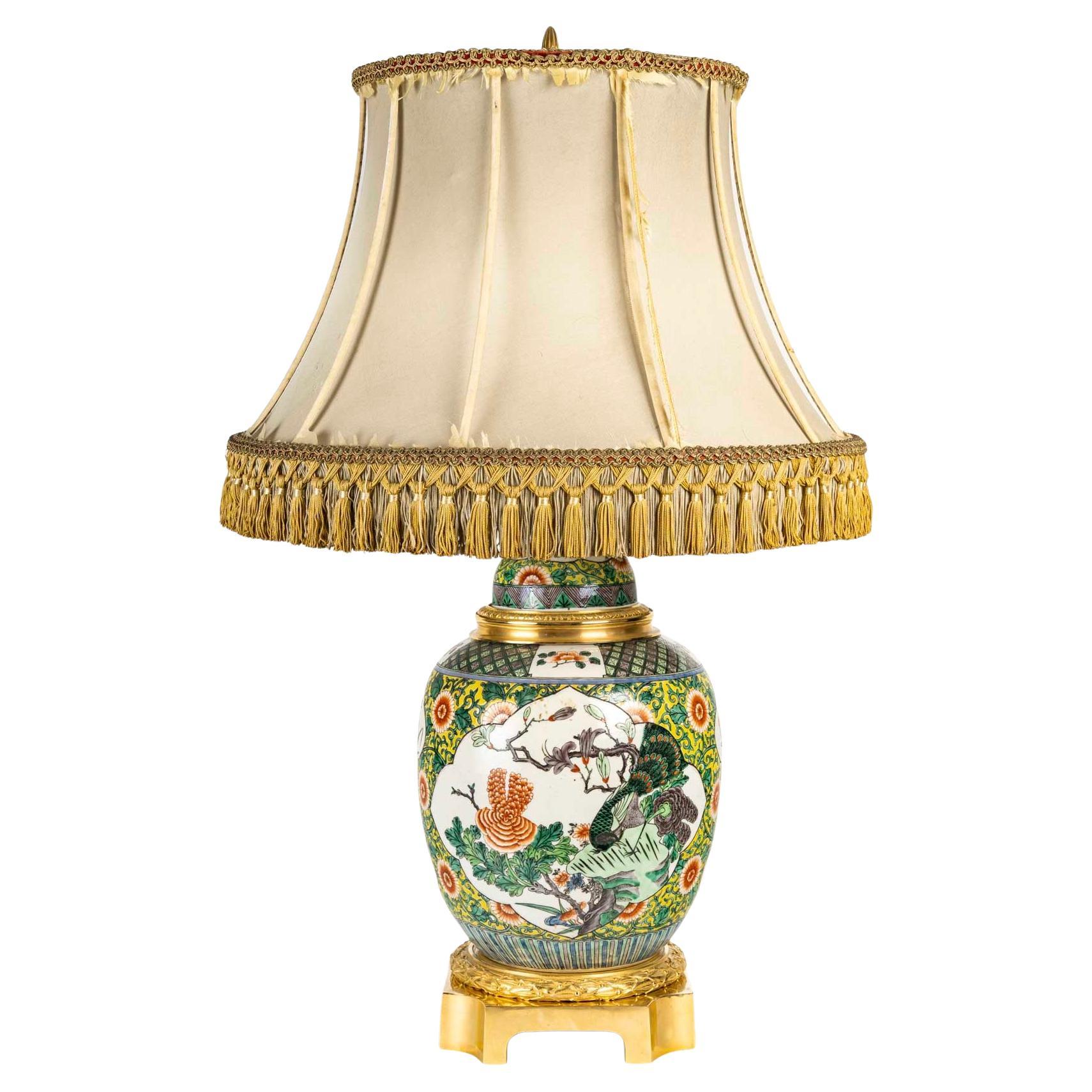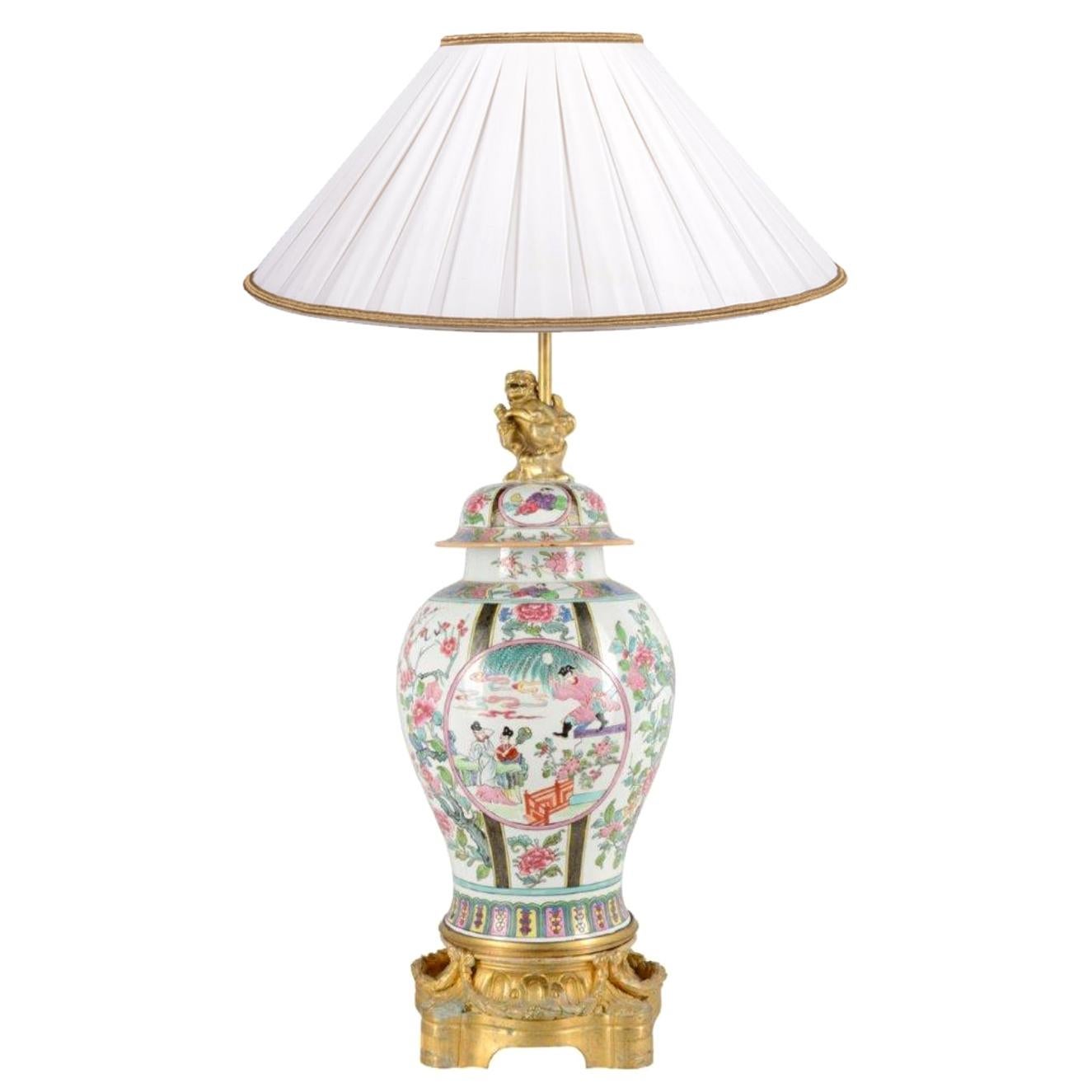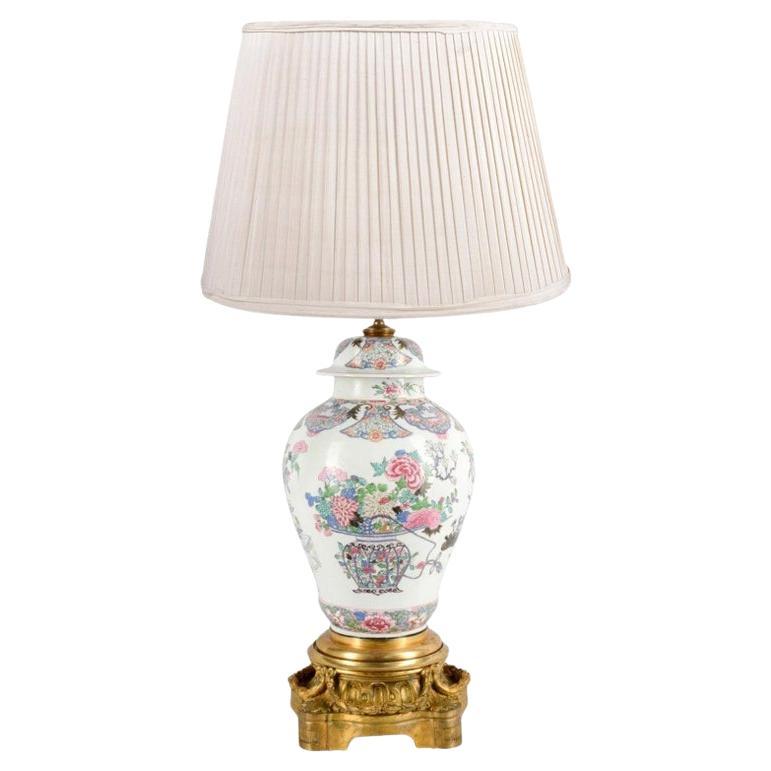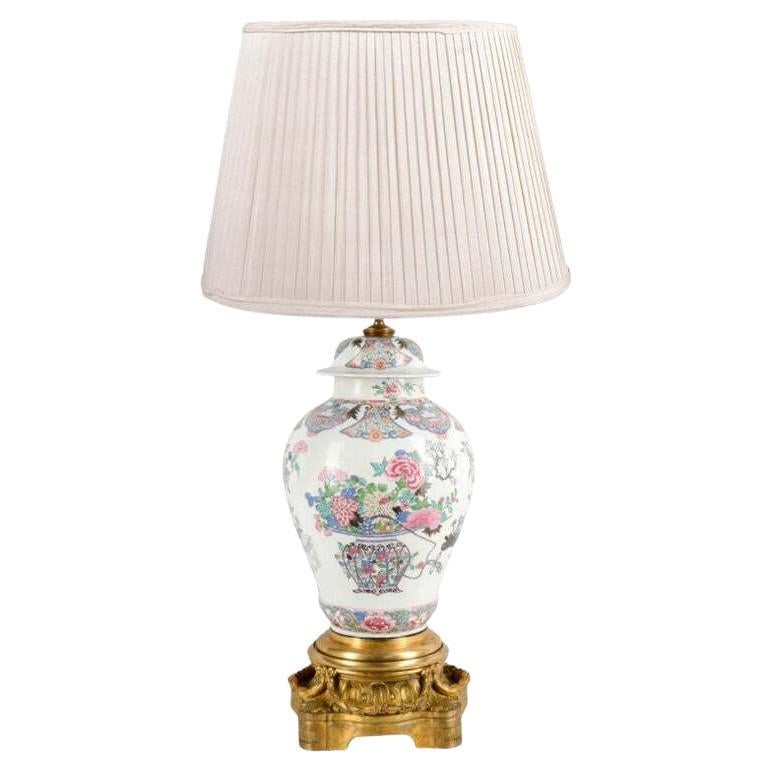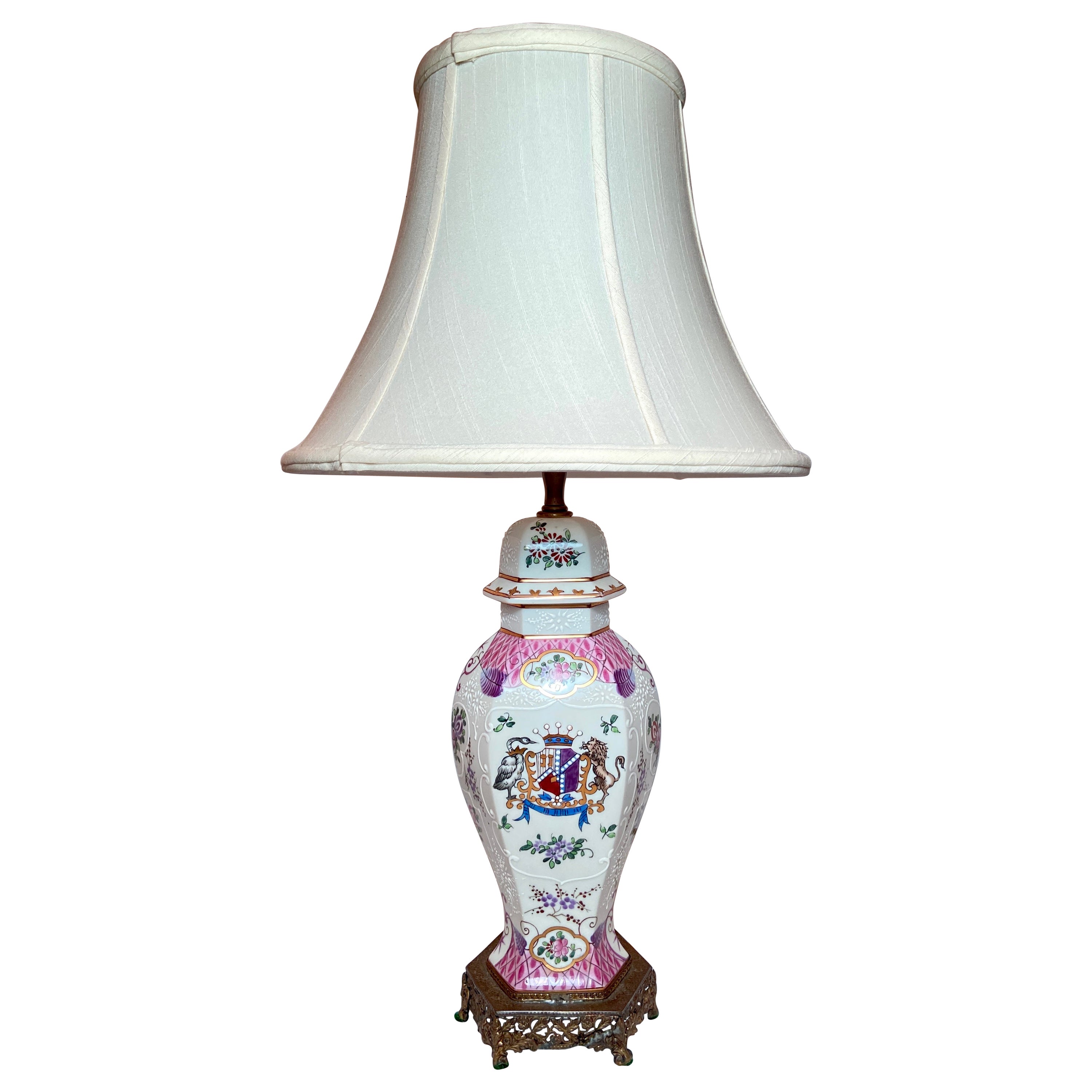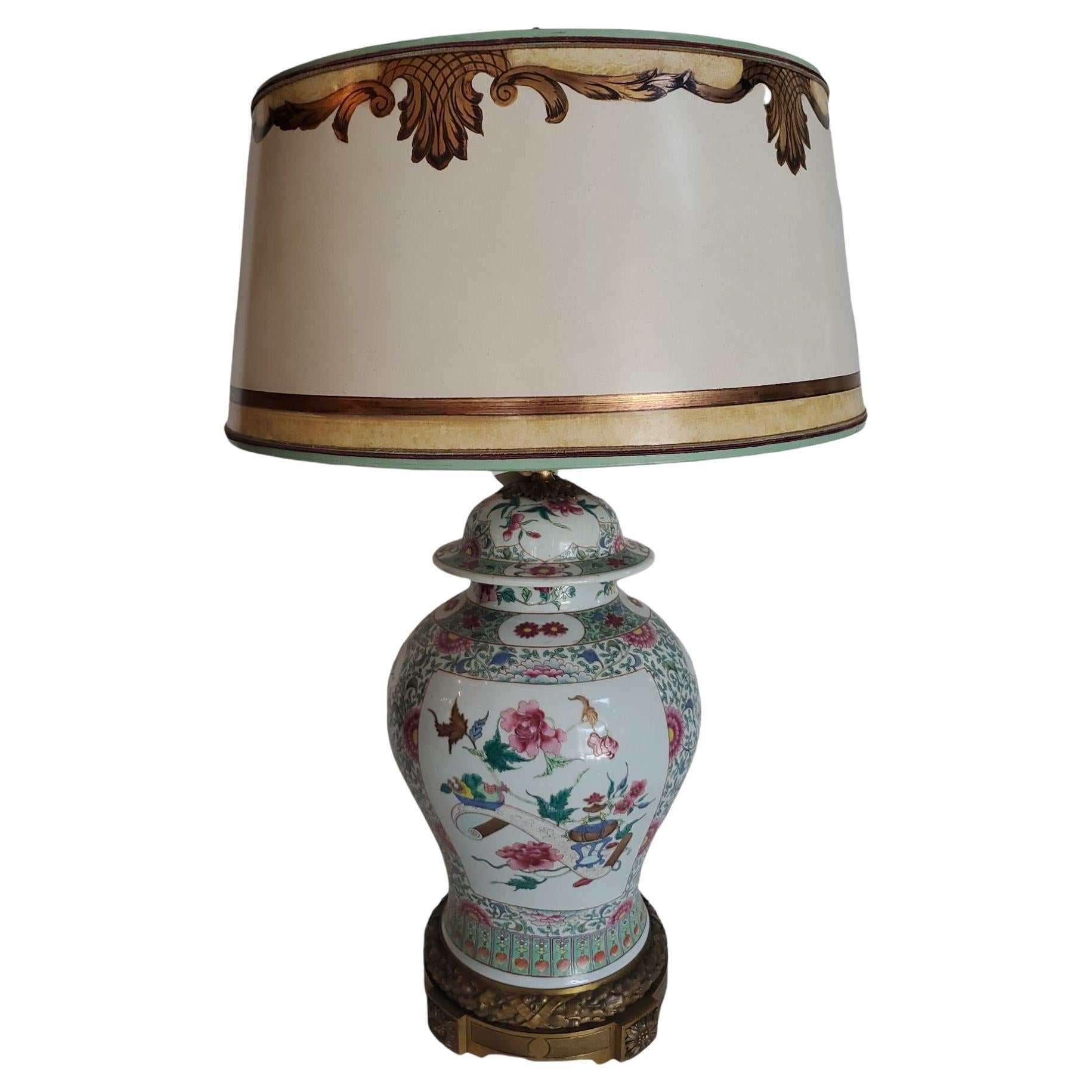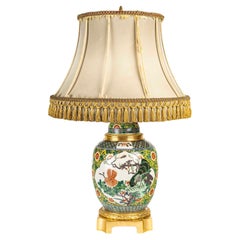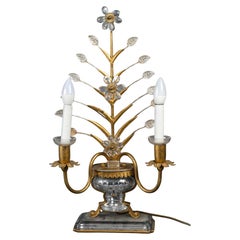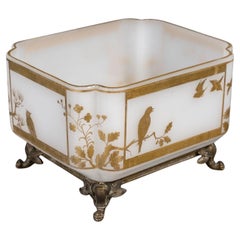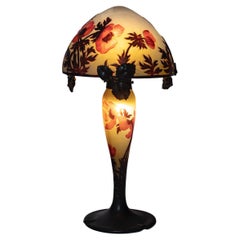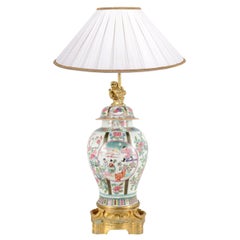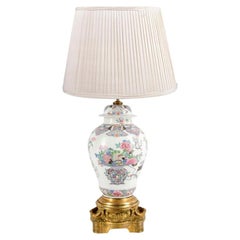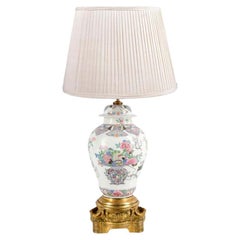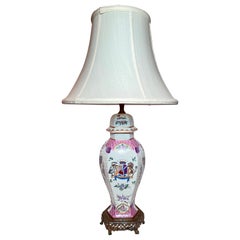Items Similar to A 19th Century Chinese Famille Rose Style Samson Porcelain Ginger Jar Lamp
Video Loading
Want more images or videos?
Request additional images or videos from the seller
1 of 10
A 19th Century Chinese Famille Rose Style Samson Porcelain Ginger Jar Lamp
$2,720.03
$3,885.7530% Off
£2,013.64
£2,876.6330% Off
€2,275
€3,25030% Off
CA$3,763.84
CA$5,376.9130% Off
A$4,149.54
A$5,927.9230% Off
CHF 2,170.91
CHF 3,101.3030% Off
MX$50,907.18
MX$72,724.5430% Off
NOK 27,327.42
NOK 39,039.1730% Off
SEK 25,555.46
SEK 36,507.7930% Off
DKK 17,329.55
DKK 24,756.5130% Off
About the Item
A 19th Century Chinese Famille Rose Style Samson Porcelain vase and cover, ormolu-mounted in lamp
Polychromed design of flowers and foliages and branches and vases, the ginger jar on a white background.
French Louis XV Style ormolu-mounts in original gilding
Together with its original used shade, surmounted on its top by an ormolu flame
Louis XV Style
Circa 1870
Lamp shade diameter 54 cm
Famille rose porcelain features polychrome decorations dominated by pink tones.
The decoration is applied overglaze, that is, after a first firing of the porcelain, which is then covered with a transparent glaze. It is during a second firing, known as a low-fire fir-ing (800°C), that the colors are set.
This type of decoration appeared during the reign of Emperor Yong-zhen (1723-1736) and developed during the reign of Emperor Qianlong (1736-1796). Its origins are closely linked to the history of trade between East and West in the 17th and 18th centuries. Indeed, it was a Dutch chemist named Andreas Cassius who discovered in 1650 the chemical formula for producing pink glazes: mineral purple, later called "Cassius purple," a precipitate obtained from gold salt. China quickly acquired this formula—purple became the "foreign color"—and then used pink tones for porcelain intended for the domestic market, but also and especially for export products.
Famille Rose porcelain very frequently features a plant motif composed of flowers and bouquets.
The "Manufacture de Porcelaines, faïences et terres-cuites" des Samson (four general) is the best example in the field of fire arts of the interest shown in the 19th century and in the first half of the 20th century to styles from the past. the 18th century as the Middle Ages or the Renaissance, and for all exoticism, Spain as Saxony or China. With a very rich, varied pro-duction and excellent quality, the Samsons were geniuses of imitation and the best reproducers of ancient pieces in terms of ceramic art.
Edmé Samson (1810-1891), a ceramic decorator established in 1845 at 7 rue Vendôme in Paris, bought his white porcelain from various Parisian manufacturers. His son Emile (1837-1913) who succeeded him, began to make reproductions of old porcelain.
Present at the Exhibition of Fine Arts applied to Industry in 1863, Emile Samson was particularly noted for his porcelain imitations of «Old Japan». He installed a factory in 1864 in Montreuil-sous-Bois, near Paris and was very successful at the Universal Exhibition of Paris in 1867 with his imitations of Saxony, China and Japan, all of very good quality.
At the 1889 World Exhibition, Samson & Cie was renowned for being specialized in large pieces of both faience and porcelain, whose models were found in the largest French and foreign museums, such as the Louvre or the Victoria & Albert Museum in London. Emile joined in 1891 with his son Léon (1868-1928), under the name of Samson & Fils, which gave a large extension to the manufacture, employing a large number of workers and decorators. In addition to the manufacture and decoration of these porcelain, the Samson manufacture also had a bronze workshop for their superb frames.
The "Manufacture de Porcelaines, faïences et terres-cuites" des Samson (four generations) is the best example in the field of fire arts of the interest shown in the 19th century and in the first half of the 20th century to styles from the past. the 18th century as the Middle Ages or the Renaissance, and for all exoticism, Spain as Saxony or China. With a very rich, varied production and excellent quality, the Samsons were geniuses of imitation and the best reproducers of ancient pieces in terms of ceramic art.
Edmé Samson (1810-1891), a ceramic decorator established in 1845 at 7 rue Vendôme in Paris, bought his white porcelain from various Parisian manufacturers. His son Emile (1837-1913) who succeeded him, began to make reproductions of old porcelain.
Present at the Exhibition of Fine Arts applied to Industry in 1863, Emile Samson was particularly noted for his porcelain imitations of «Old Japan». He installed a factory in 1864 in Montreuil-sous-Bois, near Paris and was very successful at the Universal Exhibition of Paris in 1867 with his imitations of Saxony, China and Japan, all of very good quality.
At the 1889 World Exhibition, Samson & Cie was renowned for being specialized in large pieces of both faience and porcelain, whose models were found in the largest French and foreign museums, such as the Louvre or the Victoria & Albert Museum in London. Emile joined in 1891 with his son Léon (1868-1928), under the name of Samson & Fils, which gave a large extension to the manufacture, employing a large number of workers and decorators. In addition to the manufacture and decoration of these porcelain, the Samson manufacture also had a bronze workshop for their superb frames.
- Attributed to:Edmé Samson (Manufacturer)
- Similar to:CANTON FAMILLE ROSE (Manufacturer)
- Dimensions:Height: 31.5 in (80 cm)Width: 8.67 in (22 cm)Depth: 8.67 in (22 cm)
- Power Source:Hardwired
- Voltage:220-240v
- Lampshade:Included
- Style:Louis XV (In the Style Of)
- Materials and Techniques:
- Place of Origin:
- Period:
- Date of Manufacture:circa 1880
- Condition:Wear consistent with age and use. Lampshade to be reupholstered.
- Seller Location:Saint-Ouen, FR
- Reference Number:1stDibs: LU2612344288722
About the Seller
4.8
Vetted Professional Seller
Every seller passes strict standards for authenticity and reliability
1stDibs seller since 2017
68 sales on 1stDibs
Typical response time: <1 hour
- ShippingRetrieving quote...Shipping from: Saint-Ouen, France
- Return Policy
Authenticity Guarantee
In the unlikely event there’s an issue with an item’s authenticity, contact us within 1 year for a full refund. DetailsMoney-Back Guarantee
If your item is not as described, is damaged in transit, or does not arrive, contact us within 7 days for a full refund. Details24-Hour Cancellation
You have a 24-hour grace period in which to reconsider your purchase, with no questions asked.Vetted Professional Sellers
Our world-class sellers must adhere to strict standards for service and quality, maintaining the integrity of our listings.Price-Match Guarantee
If you find that a seller listed the same item for a lower price elsewhere, we’ll match it.Trusted Global Delivery
Our best-in-class carrier network provides specialized shipping options worldwide, including custom delivery.More From This Seller
View AllA 19th Century Chinese Style Samson Porcelain Ginger Jar Lamp
By Edmé Samson
Located in Saint-Ouen, FR
A 19th Century Chinese Style Samson Porcelain vase and cover, ormolu-mounted in lamp
Polychromed design of birds, foliages and branches in cartouches, the ginger jar on a yel-low and...
Category
Antique 1880s French Louis XVI Table Lamps
Materials
Ormolu
$2,779 Sale Price
25% Off
Maison Baguès, “Urn with Flowers”Lamp circa 1950
By Maison Baguès
Located in Saint-Ouen, FR
Maison Baguès,
“Urn with Flowers”Lamp circa 1950
French Glass & Gilt Metal «Vase of Flowers» two-lights Table Lamp
Designed as a both faces crystal vase which crystal leaves and flowers on a gilt-metal stem
Since the 1860s, the renowned French luxury lighting atelier Maison Baguès has been pro-ducing pieces that are highly valued across the world. Each piece is hand assembled, using traditional techniques.
Depending on the source you consult, French luxury lighting atelier Maison Baguès was launched in Paris in 1860, or in Auvergne in 1840. Still active today, the brand remains an exemplar of French design savoir-faire.
Under founding metalsmith Nöel Baguès’s direction, Maison Baguès began as a specialist in liturgical bronze candlesticks, before late-19th-century technological advancement—and the 1880 managerial arrival of Nöel’s son, Eugène—saw the broadening of the atelier’s range to include bronze fixtures for newly-invented electrical lighting. Expansion drove the following decades, as Eugène, together with his own sons, Victor and Robert, continued to swell out the atelier’s Art Deco-tinged output. By the 1920’s, Maison Baguès’s collections included gilded iron fixtures—the iconic Parrots & Foliage hand-strung crystal chandeliers and complexly carved wall sconces —as well as metal gates, accent tables, and stair bannis-ters (which still adorn Parisian locales like the Porte Dorée and the Théâtre des Champs-Elysées).
Delicate and detailed, Maison Baguès’s bespoke designs and metalwork attracted the social elite. In 1928, eminent bourgeoisie décorateur Armand-Albert Rateau famously used a se-lection of Maison Baguès accessories to furnish the townhouse interiors of haute couturist Jeanne Lanvin. Beyond Rateau, the atelier was commissioned by many chic interiors icons...
Category
Vintage 1950s French Art Deco Table Lamps
Materials
Brass
$2,690 Sale Price
50% Off
Japonisme Ormolu-Mounted Opaline Jardiniere by Maison Baccarat, circa 1865
By Baccarat
Located in Saint-Ouen, FR
Japonisme Ormolu-Mounted Opaline Jardiniere by Maison Baccarat, circa 1865
A French Japonisme rectangular shape with double lobed corners Jardiniere
White Opaline glass with gold han...
Category
Antique 1860s French Japonisme Planters, Cachepots and Jardinières
Materials
Ormolu
Müller Frères, Lunéville, "Anémones" Art Nouveau Glass Lamp circa 1910
By Muller Fres Luneville
Located in Saint-Ouen, FR
Muller Frères, Lunéville, “Anémones” Lamp
Mushroom lamp in multi-layered glass with acid-etched and wheel-carved decoration of red and mauve magnolias in ...
Category
Vintage 1910s French Art Nouveau Table Lamps
Materials
Wrought Iron
$13,690 Sale Price
27% Off
E.Gallé (1846-1904) "Fleurs de Pommier "Soufflé Glass Vase circa 1910
By Émile Gallé
Located in Saint-Ouen, FR
Émile Gallé (1846-1904)
French Art Nouveau Cameo Mold Blown Glass Vase « Fleurs de Pommier » circa 1910
Beautiful and very rare Art Nouveau molded-blowned g...
Category
Vintage 1910s French Art Nouveau Glass
Materials
Art Glass
Émile GALLE (1846-1904) "Magnolias" Glass Lamp circa 1900
By Émile Gallé
Located in Saint-Ouen, FR
Émile GALLE (1846-1904) "Magnolias"
Important Mushroom Lamp with Magnolias design, in multilayer glass with acid-etched decoration and wheel-engraved in yellow, purple, and pink tones of foliated and flowery branches,
Gilt bronze frame with three claws and two lights
Signed "Gallé" on both elements.
Circa 1900
Bibliography :
Gallé Lamps...
Category
Antique Early 1900s French Art Nouveau Table Lamps
Materials
Bronze
$28,095 Sale Price
20% Off
You May Also Like
19th Century Famille Rose Style Samson Porcelain Vase / Lamp
Located in Brighton, Sussex
A very good quality late 19th century Famille rose style Samson porcelain lidded vase / lamp. Having classical oriental scenes with flowers, folate and motif decoration, inset painte...
Category
Antique 19th Century French Chinese Export Table Lamps
Materials
Porcelain
Samson Porcelain Famille Rose Style Lidded Vase
Located in Brighton, Sussex
A very good quality late 19th century Famille Rose style porcelain lidded vase / lamp. Having wonderful colorful floral and motif decoration with scenes of vases with exotic flowers....
Category
Antique Late 19th Century French Chinese Export Table Lamps
Materials
Porcelain
19th Century Samson Famille Rose Style Ormolu Mounted Vase / Lamp
By Samson Porcelain Factory 1
Located in Brighton, Sussex
A very good quality late 19th century Samson porcelain, Famille Rose style porcelain lidded vase / lamp. Having wonderful colorful classical oriental motif, floral and foliate decora...
Category
Antique Late 19th Century French Chinese Export Table Lamps
Materials
Porcelain
Antique French "Chinoiserie" Samson Porcelain Lamp, Circa 1900
Located in New Orleans, LA
Antique French "Chinoiserie" samson porcelain lamp, circa 1900.
Category
Early 20th Century French Table Lamps
Materials
Porcelain
19th Century Chinese Export Ginger Jar Lamp
Located in Los Angeles, CA
Covered ginger jar converted to lamp. Overall ginger jar diameter is 10.5" wide at its widest point. The custom parchment shade is 19" in diameter and 9" high. Dore bronze mounts are...
Category
Antique 19th Century Chinese Chinese Export Table Lamps
Materials
Bronze
19th Century Chinese Famille Rose Vase / lamp
Located in Brighton, Sussex
A good quality late 19th Century Chinese Famille Rose vase, having a yellow ground with floral decoration. An inset hand painted panel depicting exotic birds flowers and trees.
C...
Category
Antique 19th Century Chinese Chinese Export Table Lamps
Materials
Porcelain
More Ways To Browse
Antique French Roses
Jar Paris
Parisian China
Japanese Low Dining Tables
Old Canton
Antique Samson Porcelain
Samson French
Paris Porcelain Pink
Japan Low Antique Table
18th Century Spanish Dining Table
Old Paris China
Terre Cuite
19th Century French Extension Dining Table
Gilt Bronze Mounted Chinese Porcelain Vases
Edme Samson
Old Paris Pink
Samson China
Spanish China
